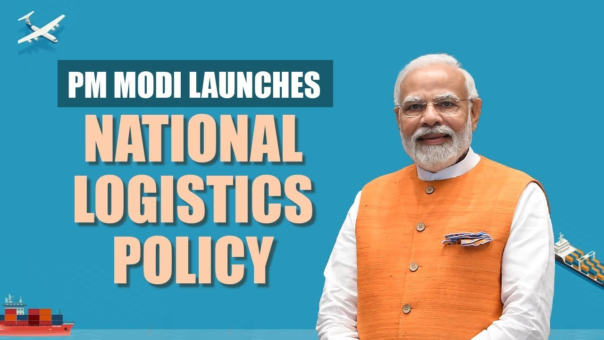National Logistics Policy PDF Download 2023 | New National Logistics Policy Explained, Meaning, Objective, Benefits, Implementation Strategy |
On Saturday, September 17, the government unveiled the National Logistics Policy, which aims to facilitate the transportation of commodities and strengthen the commerce sector in the Indian economy. Logistical costs currently represent 13 to 14% of India’s GDP, nearly twice as much as they do in developed nations. The New National Logistics Policy was created to achieve ‘quick last-mile delivery, and end transport-related challenges.

What is Logistics?
The entire procedure of acquiring, storing, and delivering resources to their intended location is referred to as “logistics“. Among other things, it includes stock, tools, people, and raw materials.
What is National Logistics Policy?
The National Logistics Policy was created to improve integration and cooperation between corporate entities, governmental organizations, and society at large to turn the Indian logistics industry into a significant driver of economic growth.
The NLP strives to establish a thriving logistics ecosystem that encompasses all participants from many industries, including business, manufacturing, services, and agriculture. The National Logistics Policy also offers a framework for supporting the improved movement of commodities through contemporary transportation infrastructure across all modes of transportation, including roads, trains, waterways, etc., along with increasing the quality of traffic control systems.
The goal of the strategy is to give multimodal connectivity infrastructure to various economic zones in addition to PM Modi’s Gati Shakti-National Master Plan, which was introduced in 2021.
Pay Challan Online
New National Logistics Policy Key Highlights
| Name of the Policy | National Logistics Policy |
| Launched by | Government of India |
| Launched on | 17 September 2022 |
| The objective of the policy | Easing the movement of goods and boosting the trade sector in the Indian economy. |
National Logistics Policy Objectives
The policy will end the silo system and put all departments and states under one roof. Consistent efforts were made to ensure quick last-mile delivery, end transport-related challenges, save time and money for the manufacturers, and prevent wastage of the agro-products. One of the manifestations of those efforts is today’s National Logistics Policy.
The policy, along with performance, will be a driving force for the Indian economy given that India is rapidly becoming a global manufacturing powerhouse and that logistics is regarded as the lifeblood of the economy. The policy will aim to address issues facing the transportation industry and reduce company logistics costs from 13–14% to under 10%. In the future, drone technology will play a significant role in transportation and logistics, particularly in rural areas.
Driving Licence Apply Online
Need for New National Logistics Policy
the logistical costs in India accounted for almost 13% of GDP. In industrialized nations, this condition does not exist. India’s exports are significantly less competitive due to high logistics costs.
Transportation services for moving goods, storage facilities that are especially important for trade in perishable goods like food, fruits, and vegetables, as well as the efficient operation of government services that assist commerce like licensing and customs are all included in logistics.
National Logistics Policy Features
- The initiative is expected to lower logistics expenses, which today represent around 15% of India’s GDP, to about 8% of GDP during the next five years. If India wants to make its exports and homegrown goods more competitive, it must dramatically reduce its logistical costs. Cost-effective logistics boost productivity in a variety of economic areas, encouraging value creation and entrepreneurship.
- By 2030, the government wants to see the country’s Logistics Performance Index (LPI) ranking among the top 25.
- The government intends to create the Unified Logistics Interface Platform as part of the NLP (ULIP). It would consolidate all digital services about transportation onto a single platform, saving exporters from a multitude of laborious and complicated procedures.
- Ease of Logistics Services (e-logs), a new digital platform, has been introduced. Businesses will be able to submit questions and issues to government agencies directly to receive prompt responses.
- Although huge, the Indian logistics sector is not well-organized. Through the policy, it is hoped to encourage the adoption of blockchain technology and artificial intelligence across the country and aid in the structuring of the megamarket.
- The development of data-driven Decision Support Systems (DSS), which will help in the development of a strong logistical ecosystem, is one of the primary focus areas of the logistics policy.
- Every state in India must set up a State Logistics Coordination Committee. Each state’s performance will be assessed annually using the Logistics Ease Across Different States (LEADS) measure. The federal government will offer a model for improving logistics effectiveness, allowing states to create their own logistics systems.
- This industry is composed of about 20 core government agencies and 40 secondary government organizations. In addition, there are 168 container freight terminals, 129 inland container depots, 50 IT hubs, banks, insurance firms, 37 export promotion committees, 200 shipping firms, and 36 logistical services.
- The Policy will be implemented using a Comprehensive Logistics Action Plan (CLAP) that emphasizes the following critical areas:
- Integrated Digital Logistics Systems
- Standardization of physical assets and benchmarking service quality standards
- Logistics Human Resources Development and Capacity Building
- State Engagement
- EXIM (Export-Import) Logistics
- Service Improvement framework
- Sectoral Plan for Efficient Logistics
- Facilitation of Development of Logistics Parks.
Voter ID Card Online
National Logistics Policy FAQs
The National Logistics Policy Sets a Framework for Growing a Sustainable and Prosperous Logistics Industry to Speed Up the Transformation of The Indian Logistics Sector.
The Government of India’s logistics initiative is the PM Gati Shakti National Master Plan, which was introduced on October 13, 2021, to provide multimodal connectivity infrastructure to various economic zones.
The National Logistics Policy aims to establish a thriving logistics ecosystem with participation from all relevant parties from various industries, including business, agriculture, trade, manufacturing, and services, among others.


